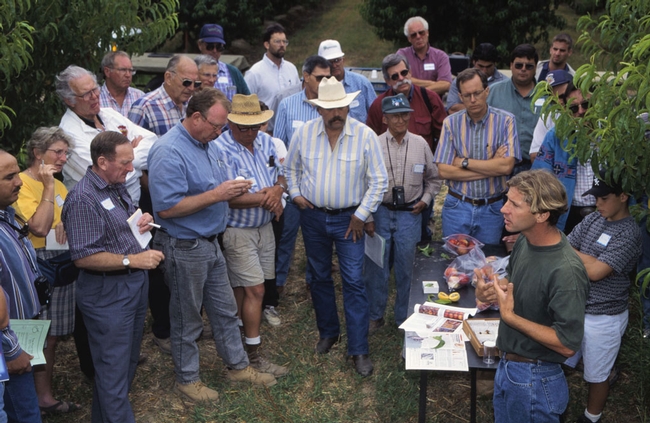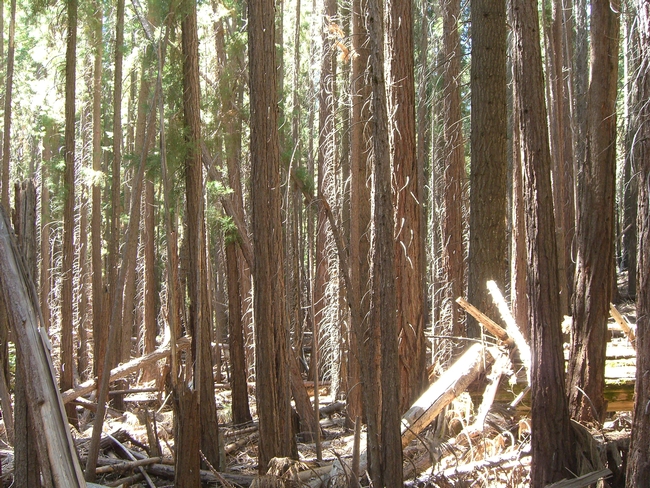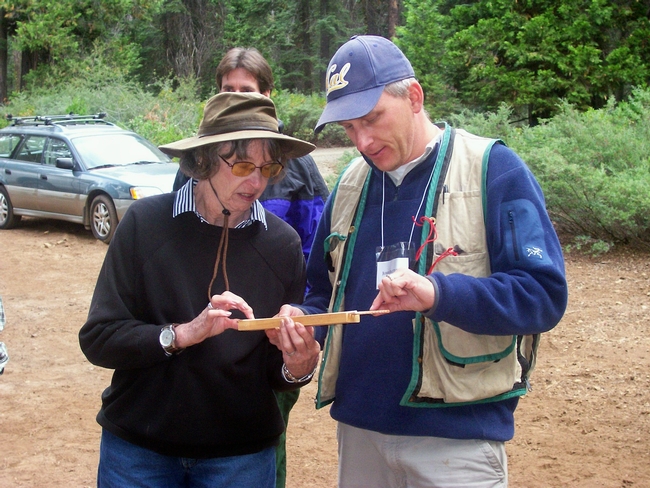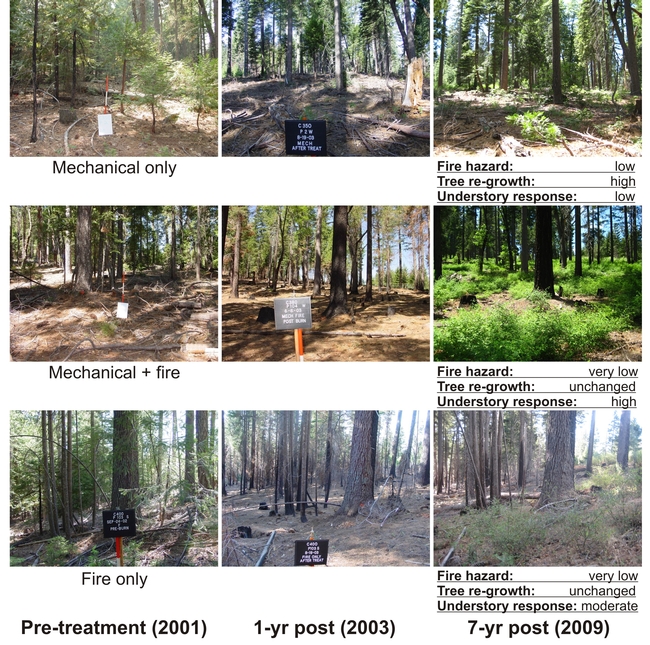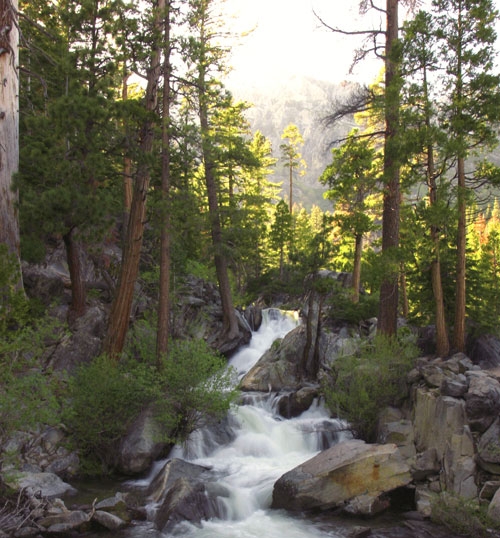Posts Tagged: John Battles
'Science' details an unconventional academic path
Throughout the United States, Cooperative Extension's 13,000 academics use new technologies to help solve problems faced by farmers, industries, natural resource managers and local communities, reported John Tibbetts in the AAAS publication Science.
The article included the thoughts of two relatively new UC Cooperative Extension academics and outlined a new UC program to support graduate students interested in cooperative extension careers.
Distinct skills are needed to be an effective cooperative extension academic. The role requires the ability to know and understand how to work with and through people, how to bring about change in communities and how to engage buy-in at the grassroots level.
"You should have good listening skills," added Lenya Quinn-Davidson, UC Cooperative Extension area fire advisor based in Humboldt County.
Quinn-Davidson also said she likes the diversity of her job. “I can be out in the field and then do a radio interview, work on a grant application, or host an event, and I'm always building relationships," she said.
John Battles, forest ecology professor at UC Berkeley said Cooperative Extension can offer an alternative academic career track for many students, but they need a way to learn the skills needed for extension success.
“In extension, you must communicate science effectively to the general public, and you don't have a 50-minute lecture to do it. You need to know how to facilitate a productive discussion in a public meeting, how to run that meeting so that everyone is heard,” he said.
To prepare students for extension jobs, UC Berkeley launched the Graduate Students in Extension program. The internship offers up to a year of funding for graduate students to conduct applied research projects and learn the principles of outreach.
Tapan Pathak, UC Cooperative Extension specialist in climate change adaptation in ag, also commented Tibbetts' article. He said extension specialists have the academic freedom to undertake research in their field as long as it addresses the needs of their clients.
Scientific consensus says U.S. Forest Service should implement proposed forest treatments
“There is currently a great need for forest restoration and fire hazard reduction treatments to be implemented at large spatial scales in the Sierra Nevada,” the scientists wrote. “The next one to three decades are a critical period: after this time it may be very difficult to influence the character of Sierra Nevada forests, especially old forest characteristics.”
The scientists' recommendation is in the final report of a unique, 10-year experiment in collaboration: the Sierra Nevada Adaptive Management Project (SNAMP). A 1,000-page final report on the project was submitted to the U.S. Forest Service at the end of 2015. In it, scientists reached 31 points of consensus about managing California forests to reduce wildfire hazards and protect wildlife and human communities.
“SNAMP was founded on a desire to work collaboratively to protect the forests of the Sierra Nevada,” said John Battles, professor of forest ecology in the Department of Environmental Science, Policy and Management at UC Berkeley and SNAMP principal investigator. “The challenges are multifaceted with a huge diversity of perspective among the public, among managers, and among scientists. SNAMP tried to bring all these interests and talents together to safeguard a vital resource and a natural wonder."
SNAMP was created to help develop a collaborative management and monitoring plan consistent with the Sierra Nevada Forest Plan Amendment, signed by regional forester Jack Blackwell on Jan. 21, 2004. The amendment called for the use of fuel reduction treatments – such as prescribed burning, mechanical chopping of underbrush, and harvesting certain trees – in strategically placed areas to slow down potential wildfires and improve forest health.
Because of disagreements over forest treatments in the past, which often led to lawsuits that languished in court for years, the U.S. Forest Service, U.S. Fish and Wildlife Service and the California Natural Resources Agency decided to take a new approach in 2005. They asked the University of California to provide unbiased scientific assessments of the impacts of the proposed treatments. UC was also charged with engaging the public concerned about repercussions of the forest treatments on wildlife habitat and water quality.
The scientific efforts and the forest treatments were all conducted in an open and transparent process. To ensure the greatest number of stakeholders were taking part, SNAMP included a public participation team of social scientists and UC Cooperative Extension outreach professionals to conduct and study the collaboration process.
Susan Kocher, UC Agriculture and Natural Resources Cooperative Extension forestry advisor in the Central Sierra, was a member the project since 2008 and served as the leader of the public participation team during the final two years, succeeding Kimberly Rodrigues, a UC forestry scientist who is now the director of the UC Hopland Research and Extension Center in Mendocino County. Kocher said having outreach and public participation included as a funded part of a science project is unusual.
“We were able to make great strides in getting everybody on the same page,” Kocher said. “That's what our data shows, too.”
A large volume of new scientific information was generated by the science team, and was published in 46 journal articles. The science spread fast and far, according to citation analysis conducted by the public participation team.
“We found that the average time it took for a SNAMP publication to be cited in another journal was about seven months,” Kocher said. “Citations to our articles came from all over the United States and around the globe.”
In addition, SNAMP science-based information was immediately useful to forest managers, according to a 14-page response to the SNAMP final report by the Forest Service, Fish and Wildlife and the California Natural Resources Agency. For example, an excerpt of the response submitted by California Fish and Wildlife noted that “SNAMP proved successful at modifying treatment methodology to meet the ever-changing reality of forest management.”
“The results were able to prove useful for managers past and future regarding how management can be implemented, in the face of wildfires while still retaining important owl nesting/roosting and foraging habitat features in and near owl activity features,” the document said.
SNAMP – funded with $15 million in grants mainly from the U.S. Forest Service, with support from U.S. Fish and Wildlife, California Natural Resources Agency and University of California – ran from 2007 to 2015. The project ended with the submission of the final report that contains details about the study areas, the treatment processes and reports from each of the six science teams. The science teams and their final reports are:
- Fire and forest ecosystem health
- Spatial - The study of forest canopy and understory with remote sensing technology called lidar, which uses reflected light for analysis.
- Wildlife: California spotted owl – A bird that is dependent on high-canopy forests.
- Wildlife: Pacific fisher – A weasel-like nocturnal animal that roams a wide area and nests in the hollows of old-growth trees.
- Water quality and quality
- Public participation
A key chapter in the publication is titled Integrated Management Recommendations. In it, the 31 points of consensus are outlined.
“The integration in this project is also unique,” Kocher said. “Scientists tend to work in their own focus areas, but we can learn a lot from each other's research projects.”
Working together, the scientists looked at all the research outcomes. The first 18 recommendations in the chapter are the direct result of scientific research conducted in SNAMP projects; the remainder of the recommendations are based on other scientific work and research.
Each of the recommendations is linked to a management goal. Some goals may conflict with achieving one or more of the other management goals. This approach to organizing the recommendations was taken to demonstrate that, while many of the management recommendations do not clash, a few may. For example, suggesting treatments across a landscape in a way that minimizes the negative effects on wildlife might reduce the efficiency of treatments aimed at reducing wildfire behavior and impacts.
The next steps are for the U.S. Forest Service to consider and adapt the SNAMP results and recommendations to continue to restore and protect the natural resources at risk in the Sierra.
“My hope is the SNAMP will be seen as a promising first try to apply adaptive management in the Sierra Nevada,” Battles said. “We gained important new insights about the ecology of these forests and we learned how to conduct applied research in an inclusive manner that engages not only scientists from multiple disciplines but also managers and the public."
The effects of density and high severity fire on tree and forest health
Hike off-trail through most any part of the Sierra Nevada and you may find yourself losing your hat to a low hanging branch, your shoe to a thicket of dead and dying brush, or your companion to the crevice hidden by the wall of young trees.
There is no doubt that the forests of the Sierra Nevada, while amazingly beautiful, have grown dense with vegetation. Consequently, forests have become increasingly susceptible to high severity fires, which negatively impact the forest's overall health and our ability to enjoy it.
There is a relationship between a healthy forest and its density. The denser the forest, the more competition individual trees have for valuable resources, such as water, light and nutrients. The effects of competition on tree growth and death are profound – the more trees per acre, the smaller the diameter of the individual trees (meaning less growth) and the higher the likelihood trees will be negatively impacted by pests, diseases, and poor health, ultimately leading to tree mortality. Theories in ecology, supported by field data and statistical analysis, predict that some trees will outperform others and the difference in performance increases with crowding. Unfortunately, evidence suggests that excess density is causing increased mortality in the Sierra.
John Battles, forestry professor at UC Berkeley and member of the Sierra Nevada Adaptive Management Project (SNAMP), is leading a team of UC Berkeley researchers and graduate students in developing vulnerability profiles that will help to quantify individual trees' probability of survival. The growth response of individual trees is the primary measure of forest health in the SNAMP study. The team believes growth is an excellent indicator of tree vitality and that a necessary (but not sufficient) condition for a healthy forest is healthy trees.
The team collected and processed more than 12,000 tree cores to develop long term growth and vulnerability profiles for different tree species. Their results supported the accepted notion that, in general, good growth was an indicator of good health. However, they also found that "bad years," when growth was substantially lower than normal, were strong predictors of death. In addition, they reported that bad years had a cumulative impact that spanned decades. In other words, the best predictor of potential death was for a tree to experience two or more bad years over the most recent 20 – or even 40 – years. The team has been working to translate these relationships between tree growth and survival to produce a vulnerability index by species and size. One goal is to have some sense on how vulnerable a stand is before many trees start to die.
Another key question being asked by SNAMP researchers is whether fuels treatment projects designed to modify fire behavior also improve forest health. Battles and his team hypothesize that thinning a dense forest will improve individual tree and overall forest health, as well as reducing fire risk. Resilience, or the capacity to recover from adverse conditions, is the goal. Histories captured in tree core samples show that trees can survive adverse conditions such as fire and drought. While studies have shown that properly implemented fuel treatments are effective at reducing hazardous fire potential, there are secondary ecological effects that can impact forest resilience either positively or negatively depending on the treatment type, timing and intensity. In a study at the UC Blodgett Forest Research Station, researcher Brandon Collins and others looked at large, dominant tree growth responses, measured seven years after the implementation of some of the most common fuel treatments, to estimate that forest's health. Across the five tree species analyzed, observed mortality and future vulnerability were consistently low in the areas where only mechanical treatment occurred. Fire-only treatment had results similar to areas that did not receive treatments for all species except Douglas-fir. Mechanical-plus-fire treatments, however, had high observed mortality and future vulnerability for white fir and sugarpine. Given that these large, dominant trees play a key role in terms of wildlife habitat, carbon sequestration and soil stability, these results have implications for understanding longer-term impacts of common fuel treatment types on forest resilience.
Through the analysis of tree core samples, Battles and his team hope to provide clarification on conditions that improve individual tree health and the overall health of the forest. The final report on SNAMP, with the results of the forest health study described here, will be available May 31, 2015, at http://snamp.cnr.berkeley.edu/.
Land donation to double UC research forestlands
The University of California will add 4,584 acres of Northern California mixed-conifer forest to its research lands, doubling the size of UC’s research forests, as a result of a land donation approved yesterday (November 16) in Sacramento. The transfer is the largest single acquisition of forestland in the University’s history.
The donation was approved at a meeting of the Pacific Forest and Watershed Lands Stewardship Council, a private foundation that was established in 2004 as part of a Pacific Gas and Electric Company (PG&E) bankruptcy settlement to ensure that over 140,000 acres of California's pristine watershed lands are conserved for the public good and to serve California's young people.
“This four-and-half-thousand acres is a tiny portion of the total PG&E lands, but it’s an enormous boon to UC’s research and outreach capabilities,” said J. Keith Gilless, a professor of forestry and dean of the UC Berkeley College of Natural Resources, which houses the UC Center for Forestry.
The UC proposal focused on learning how California’s working forests in key watersheds can be managed to sustainably provide essential ecosystem and climate benefits over the next century.
The new lands will enable researchers to:
- Learn how different components of forest ecosystems will respond to climate change, increasing fire risks, and invasive species;
- Use and measure a range of forest-management approaches, including reserves, to better understand all the forest ecosystem components;
- Broaden outreach to K-12, community college and university students; researchers; and the public.
“The University’s goal is to harvest knowledge, not timber,” Gilless said.
UC’s proposal received widespread support from the research community, including Yale University, Cornell University, Oregon State University, Northern Arizona University, and the University of British Columbia.
John Battles, a professor of forest ecology at UC Berkeley, said that UC shares the goals expressed in many public comments, which stressed the value of intact forests, tall trees and wildlife habitats. But Battles also noted the importance of research.
“Conservation in this era of change is confronted by the reality that no ecosystem, no matter how remote or wild, is protected. We want to be proactive by learning how to build resilient forests under a changing and stressful climate,” he said.
At Wednesday’s meeting, the Stewardship Council board of directors also approved a donation of 7,016 acres to the California Department of Forestry and Fire Protection (Calfire) for a new state demonstration forest that will be located adjacent to the new UC forest parcel near the Pit River in Shasta County. The Stewardship Council also discussed funding a shared research and outreach facility that would be shared by the two public entities.
Together, the UC and Calfire donations significantly expand the existing research and demonstration state forests owned and operated by state entities and will complement the forest research currently conducted on US Forest Service and National Park Service lands.
“The addition of new forest types and locations broadens the ability of UC Center for Forestry to collaborate with a range of public and private forest owners to conduct critical research and education on forestry management, climate change and other issues affecting the Sierra and Cascade ranges,” Gilless said.
The donation comprises two locations: 3,100 acres near the Pit River in Shasta County, on the west side of the Pit-McCloud watershed, and 1,484 acres in the Lake Spaulding area in Nevada County, near the top of the Yuba-Bear River watershed. Before this donation, the UC Center for Forestry held 5,131 acres over four research sites in Contra Costa County, Plumas, Tulare and El Dorado counties.
Due to land survey work and the California Public Utilities Commission's detailed land-transfer process, the Stewardship Council estimates that UC will take possession of the new lands in approximately one year.
Related story: New Report Highlights Carbon Benefits of Forests
Sources:
John Battles, Professor of Forest Ecology, UC Berkeley, (510) 643-0684
J. Keith Gilless, Dean, UC Berkeley College of Natural Resources; Professor of Forestry, UC Berkeley, (510) 642-7171
Bill Stewart, Director, UC Center for Forestry; Cooperative Extension Forest Management Specialist, (510) 643-3130, (510) 318-0377 (cell)

